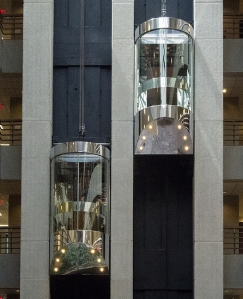While in the best of times I felt like there was a disconnect, when the economy tanked I understood the lack of funds. Today I am seeing money spent, but from my perspective unwisely. I see the possibilities of how I could really help clients.
If you are thinking like this maybe the key is to rethink how you are doing business.
There are three sides to every story—yours, the truth and mine.
I have been coordinating a group of photographers for a few years now. We meet quarterly in the Atlanta area. We started giving everyone the opportunity to give a two-minute presentation. So few could adhere to the time limit I changed it to five-minutes and still most cannot get their material presented in the time frame.
Frankly this is a key insight into why so many photographers are failing today—they waste people’s time. If you are not clear as to what you do and can help others do then no one else will understand as well.
Your Elevator Speech
You should be able to tell people what you do in an “elevator speech.” This is a very concise short summary of what you do and has a value proposition. The name comes from the amount of time it takes to ride an elevator to your destination, which is usually thirty seconds to two minutes.
If you do not have an “elevator speech” I would recommend putting one together. It is very similar to a Mission Statement or Vision Statement.
Start with these parts:
• Define who you are
• Define what you do
• Define how you are different
• Define your audience
• Call to action
• Why should they care
Refine each of these and then assemble this and start with the why. This is the hook to pull them in. Here is one example I have used a few times.
Have you ever given your elevator pitch and realized they just need to see it to believe it? This is what I help companies do everyday. I help them with visual storytelling.
I have on my phone, iPad, computer and website a quick slide show that is my two-minute elevator speech. When I am talking to someone I am showing a few examples of what I do to accompany my narrative.
Time to Listen
After you have done this long enough you will get clients that know you and recommend you. Once you have some people using you, then you can go to them and see how they would describe you. In a way you are looking for your two-minute speech, as they would give it on your behalf.
I recommend going deeper than this and really get to understand how others define you.
You can hire a professional coach who will help you do a 360 where they talk to people and find out how others see you. If you don’t have the resources to do this, then you just need to approach some clients and ask them for some time to help you out.
You could do a focus group. You can choose to get a group of people together or you can do this one-on-one. The key here is to treat this like a focus group. Most people are compensated for their time. My suggestion is to have a game plan and timetable.
Be upfront with what you are doing and respect their time. Maybe offer to take them to lunch and tell them you need about 90 minutes of their time. Set aside 30 minutes to eat and then take the time they agree to remaining, ask your questions and when time is up, not when you finish your questions stop.
Some people may not want to be all that honest and upfront, so you may have to bring up touchy topics by saying some people say that you are strategic but not good with follow through, and then ask them if they agree or disagree.
You might find out that you come across as an arrogant person. All this time you thought you were being helpful and now you are finding out you were sabotaging your brand.
Whatever you find out remember they think highly enough of you to meet with you and want to help you. This is why after you have heard some weaknesses you might want to ask what are some things they suggest to make a change.
Look for a consensus before making changes. The patterns are what you are listening for and not each individual comment alone.
The Truth
We judge ourselves by what we feel capable of doing, while others judge us by what we have already done.
–Henry Wadsworth Longfellow
My mentor, Don Rutledge, used to say to me that the best judge for a photography contest is the public, because they will judge the photograph merely on the impact it has on them. He went on to say that as practitioners of photography we should study which photos have the most impact and understand why.
If you take the time to listen to how you are perceived then you are now ready to make the necessary adjustments to help you grow in your business.
Take all those positive comments and be sure those are now part of your “elevator speech.”
Take the constructive criticism and make some changes. Let’s say people think you come across as a know-it-all or arrogant. Maybe instead of just shutting down all your comments, you ask nonthreatening questions. Have you ever thought about …?
You may need to practice this new way of bringing up your concerns or ideas. Remember it will take time to make these adjustments.
When you lack a hook
You maybe fully aware of your brand and what you offer, but you still are not getting business.
Your business model is not addressing the needs or desires of the customer or they would be using you.
A few things can be happening here and you need to be honest with yourself.
Possibilities:
• They need what I offer, but can get this somewhere else
• They don’t see what I offer as a need
• What I offer isn’t desirable. Think luxury here
Be sure your elevator speech is not about facts but is about emotions. When you are able to hook into people’s emotions, then you will be successful.
Some wedding photographers say they take pictures of weddings, some say they are helping families write the first chapter for their new family. Which one is getting to the core of what they offer?

































